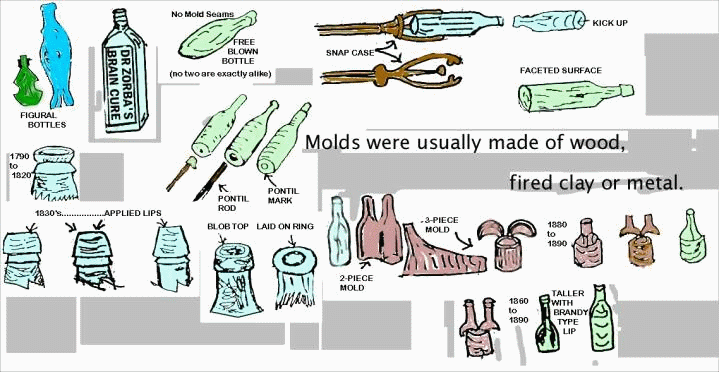 |
IMAGES AT BOTTOM OF ARTICLE
VALUE: Bottle evaluation is largely controlled by (1) Supply and Demand; the more scarce the bottle the higher the price; (2) Age; (3) Pontil Marks, Mold, Seams, Embossed Lettering, Color??such as ColbaltBlue, Black Glass or Amethyst Colored Glass, etc.; (4) Unusual Shaped Bottles or Figural Bottles; (5) Although the condition of the bottle is very important??such as no permanent stains or flaws.
HOWEVER, there are always exceptions?? not all battles have to be of vintage age to bring premium prices.
AVON & JIM BEAM are just two examples.
THE DATING OF BOTTLES is sometimes very difficult because methods of bottle making often overlapped each other ? changes were gradualand different methods wereused at one time.
THINGS TO LOOK FOR When Determining The Age Of A Bottle:(1) type of lip; (2) bubbles; (3) embossing; (4) location of seams or mold marks??2 or 3 piece molds; (5) pontil marks. (seams on machine made battles go up and over the lip).
BOTTLE TERMS:PONTIL MARKS??scar on the bottom of the bottle which was causedfrom the long rod. Pontil Rod which the glass blowers used to hold the hot bottle while applying the finish tothe top. The rod was dipped in molten glass, and then stuck to the base of the bottle and was broken off when finished thus forming pontil mark.
BLOWPIPE??A long tube used by glass blowers to gather and blow the liquified glass into molds or create unique pieces without the use of a mold, known as Free Blowing.*Free blown bottles bringpremium prices. Most bottles were pontiled up to 1840 when the Snap Case was used to hold the bottle instead. It consisted ofa long rod which had two clamps on the end designed to fit a particular bottle, these clamps would snapshut around the base of the bottle, enabling the glassblower to finish the bottle. KICK?UP??indentation at the base of the bottle.
WHITTLE MARKS—Irregular wavy marks that appear on many bottles which were made before 1900 caused by the many small shriveling contractions which happen when the hotglass is blown into a cold mold.
EMBOSSING??Raised lettering generally made by using a plate mold which was put inside the casting mold. This caused a depressed area in which the lettering was boldly formed when the bottle was formed.
ETCHED LETTERING??Done by hand on earlier bottles using caustics or sharp instruments or fine grinding tools??these bottles bring a premium price to collectors.
BUBBLES, TEARDROPSor SEEDS??Generally bubbles appear on glass made before 1900's caused from the glassblower gathering molten glass from the top of the vat with the blowpipe, where the boiling glass would be full of bubbles. Later, bottle machines were designed to take the liquid glass from the middle of the batch, instead of from the surface.
TYPES OF LIPS: APPLIED LIP??Lip and mouth of the bottle was handmade and applied to the bottle after the bottle was made with the blowpipe.
SHEARED LIP??The bottle was cut free from the blowpipe with a pair of shears. A bottle with this type of lip was made up until the mid 1930's.
TYPES OF MOLDS:OPEN or DIP MOLD??First type of mold used, this mold would form only the main body of the bottle,the rest of the bottle had to be worked out by hand. This type of mold was generally a hollow cylinder. The bottle will have a mold mark where the slope of the shoulders start, the surface will be rough and pimply.
CLOSED MOLD??Entire bottle was formed including the lip and neck??this type of mold became a standard in the industry.
2 PIECE of BIMAL MOLD??1860 to 1900 (early 2?molds have applied applied tooled lips while later 2?molds were fully molded with lips finished by a wiping process.)
3 PIECE MOLD??1820 to 1880 but not so common from 1850 on, because of the use of the more economical 2?mold. The earlier 3?molds were generally blown in black glass.
TURN MOLDS??1860 to 1890 bottles were spun in the mold while still hot. This erased the mold marks which forms a smooth surface. No mold seams are visible but often horizontal parallel lines (spinned effect) can be seen on these bottles.MICHAEL J.OWENS of the Toledo Glass Co. brought revolutionary changes to the glass industry with the invention of the "Owen Fully Automatic Bottle Machine" in 1903.
GLASS??The main ingredients for glass mixture is SAND, SODA & LIME. All sands contain iron oxide which causes the aqua (blue?green) color of bottles made from untreated glass batches.
CLEAR GLASS was demanded by the food industry, around 1860 to display their foods better. Bottle makers added MANGANESE or SELENIUM to the mixture to remove the greenish tint from their bottles. When this glass is exposed to the sunlight it turns a beautiful purple.
GLASS COLORS??Controlled by the basic ingredients of the glass batch.
BLACK GLASS very dense olive green or olive amber which appears to be black, unless held in front of a bright light, on some of these bottles light cannot even penetrate thru. This color is caused from the impurities in the glass batch??Iron Slag and Carbon.
GREEN or AQUA—Most common colors??caused from Iron Oxide impurity in the glass batch.
COLBALT BLUE??Colbalt was added to the glass batch to make the color.
AMBER??Nickel addedRED??Copper or gold added to the batch, a desired color
MILK BLASS??Tin or Zinc added, generally used for more special glassware and bottles.(Generally the most common colors are AQUA??light green or light blue tint. BLUE?GREEN, OLIUE?GREEN & BROWN OR AMBER)
PURPLE?AMETHYST or SUN COLORED GLASS??1890?1914 caused from the manganese ingredient in the glass being exposed for a period of time to the ultra?violet rays of the sun??the bottle' was originally clear. Intensity of purple depends on amount of manganese, and amount of exposure. This can be done artificially with a special bulb. ("Bottle Beginner's Notebook" was taken from a publication from the South Jersey's Heritage Bottle and Glass Club, written by James C. Blackie)
